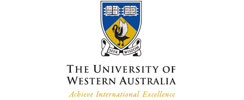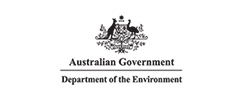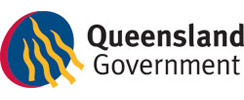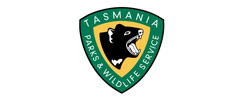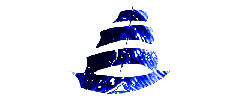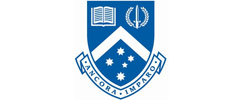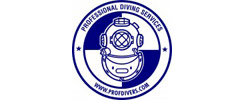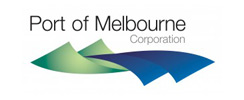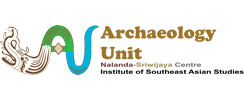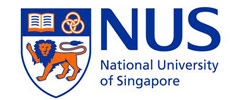Sunday 29 April
The finds recording team have been extremely busy recording and documenting all artefacts that have been raised using a specifically designed FilemakerPro database for this project. This one database accommodates separate recording of both artefacts and samples (site and artefact) for analysis by conservation and other researchers on the team. Artefacts are being systematically tagged, closely examined, recorded, photographed than wrapped and prepared for reburial on the jack up barge in the conservation and finds recording areas. The finds recording team and the conservation scientists have been working very closely together on these and it has been full on!
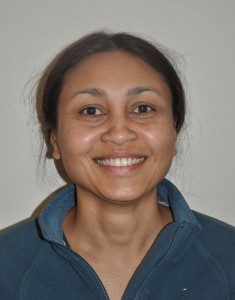 |
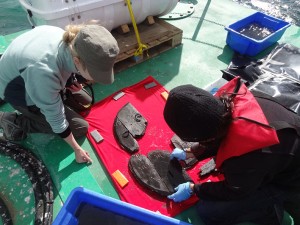 |
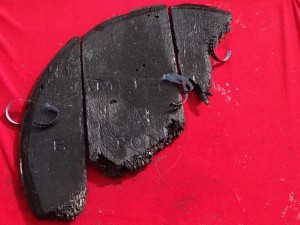 |
| Jennifer Rodrigues | Amelia Lacey and Jen Rodrigues (Photo by Fiona Shanahan) | One of the cask heads with visible branded letters |
More wooden casks were raised today in addition to those raised in the last few days. So far three wooden casks (in addition to ceramic, glass, leather and metal artefacts) have been raised. The cleaning of the wooden casks by our wonderful volunteers under the (friendly!) watchful eye of our conservation scientists, has revealed branded letters on the exterior face of the casks heads, evidence of repair, remains of iron hoops on the exterior of the staves, tool marks on the timber surface indicating construction techniques used, as well as curved lines deliberately marked onto the interior of the staves and head pieces across the joints which corresponds to adjacent pieces. This helps the cooper in reassembling the casks more quickly by being able to position the staves and head pieces in the right places. If a cask has been disassembled and stored in the form of ‘shooks’ (staves and head pieces stacked in a pile), this takes up less space than an assembled cask but when the use of a cask is required, a cooper has to assemble all of the staves, head pieces and hoops in the right order. These markings are therefore critical in understanding the construction, use and context of these vital cargo elements. These casks are made of oak and appear at this point to be wet casks (i.e. used to store liquids). Further research will be carried out on these and other finds. Ian MacLeod and Vicki Richards also used a pilodyn to measure the extent of deterioration of some of the cask staves as they were brought into the conservation area and these were found to be very degraded despite appearing to be in very good condition. X-rays of some of the pieces also confirmed extensive degradation by marine worms.
The casks were raised using specially designed crates modified by Vicki Richards and Jen Rodrigues. All artefacts raised were cleaned by Ian MacLeod, Celeste Jordan, Mike Nash, Fiona Shanahan, John Osmond and Joe Brothers. In addition to the artefacts, Ian MacLeod’s fantastic brushing of the deck of the jack up barge (of seagull excretion!) now means that we can see the floor again. Thanks Ian! Eric Bruning has officially declared war on the seagulls so life is about to get even more interesting on the barge. Fiona Shanahan has been a huge help in carrying out a variety of jobs for the finds recording and conservation teams. She left today for Melbourne and we wish her all the best for the rest of her academic year. Amelia Lacey has also been helping to photograph and record the artefacts. She has been an absolutely brilliant help!
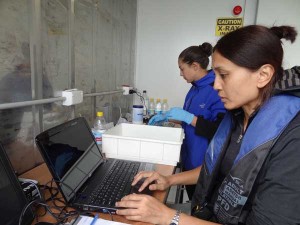 |
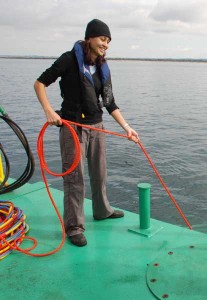 |
| Deb Shefi assisting Jen Rodrigues in the Finds recording area (photo by Fiona Shanahan) | Jen Rodrigues on Dive tender operations between finds recording and conservation work (photo by Ian MacLeod) |
Pete Veth took a number of clay and sediment samples from different depths inside the wreck site for analysis. There is an interesting mix of terrestrial derived grains, very fine clay and wood from an anoxic environment, suggesting complex deposition pulses. The wreck appears to have been a sediment trap reflecting major flood events in the Port Philip Bay catchment before the 19th Century. Finally, Liesel Gentilli, who takes over from Andy Viduka on the X-ray duty, carried out X-raying of an animal bone, thought to be associated with one of the casks from the wreck. More X-raying continues as finds are raised and processed.
Michael Gregg (Maritime History Curator from the Western Australian Museum) and a qualified Master 5, joined the team on Saturday and was immediately (and I mean immediately!) put to work on the support boat Trim to also give Pete Harvey (her normal skipper from Heritage Victoria) a chance to dive on the Clarence and spend some time on the jack up barge with the team.
Lyall Mills dropped by the holiday units on Sunday to pick up his boat which he loaned to aid the sandbagging task. Thanks so much Lyall! MAAV (Maritime Archaeology Association of Victoria) members, including a terrific bunch of other professional divers from PDS (Professional Diving Service), came again today to help the team with a variety of tasks which included excavations and artefact cleaning and sorting. Thank you so much to these guys for their invaluable help!
Vicki Richards and Fiona Shanahan went for a snorkel on the Clarence site for the first time today on the rare occasion they had to see the site – well, they were going to snorkel regardless of how much work there was on the barge anyway, and who can blame them with such an engrossing project?
Dr. Jennifer Rodrigues Vice President Australasian Institute for Maritime Archaeology (AIMA)